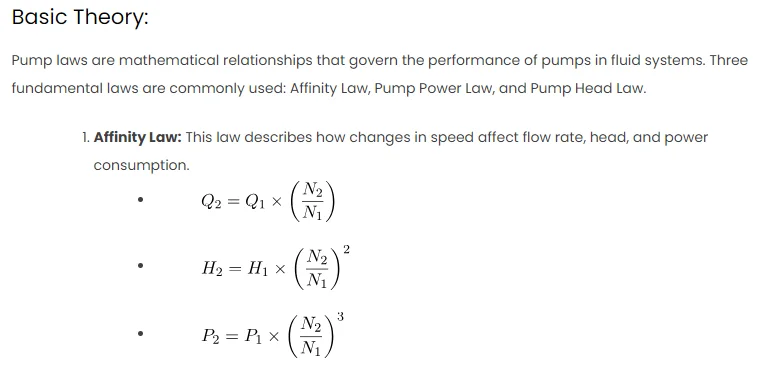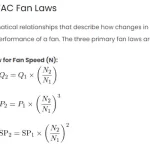HVAC pump laws are also known as affinity laws or fan laws. They are used to express the relationship between variables involved in pump performance, such as flow rate, pressure, speed, and power. They apply to pumps that are dynamically similar, meaning that the ratios of the fluid forces are the same.
Basic Theory:
Pump laws are mathematical relationships that govern the performance of pumps in fluid systems. Three fundamental laws are commonly used: Affinity Law, Pump Power Law, and Pump Head Law.
- Affinity Law: This law describes how changes in speed affect flow rate, head, and power consumption.
-
- Pump Power Law: This law describes the relationship between power, speed, and impeller diameter.
-
- Pump Head Law: This law defines the relationship between head, speed, and impeller diameter.
-
Procedures:
Now, let’s apply these laws in an educational example using Microsoft Excel.
- Open Excel and create a table with the following headers: Speed (RPM), Flow Rate (Q), Head (H), Power (P).
- Enter initial values for Speed, Flow Rate, Head, and Power in cells B2:E2.
- Use Excel formulas to apply the Affinity Law to calculate the values for a different speed (let’s say 1200 RPM). Repeat for Pump Power Law and Pump Head Law.
Scenario:
Let’s consider a scenario where an HVAC system operates at 1000 RPM with a flow rate of 500 GPM, head of 50 ft, and power consumption of 10 kW. We want to know the system performance at 1200 RPM.
Excel Formulas:
Calculation:
- Speed (RPM): 1000 (initial), 1200 (target)
- Flow Rate (GPM): 500
- Head (ft): 50
- Power (kW): 10
Now, apply the formulas in Excel to find the new values at 1200 RPM.
Result:
| Speed (RPM) | Flow Rate (GPM) | Head (ft) | Power (kW) |
|---|---|---|---|
| 1000 | 500 | 50 | 10 |
| 1200 | [Result] | [Result] | [Result] |
MATLAB Comparison:
In MATLAB, you can use similar equations to perform the calculations. Here’s an example script:
N1 = 1000; N2 = 1200;
Q1 = 500; H1 = 50; P1 = 10;
Q2 = Q1 * (N2/N1);
H2 = H1 * (N2/N1)^2;
P2 = P1 * (N2/N1)^3;
fprintf('Flow Rate at 1200 RPM: %f GPM\n', Q2);
fprintf('Head at 1200 RPM: %f ft\n', H2);
fprintf('Power at 1200 RPM: %f kW\n', P2);


